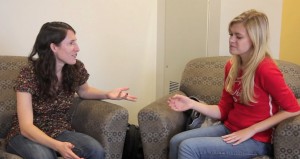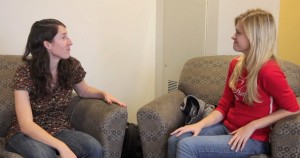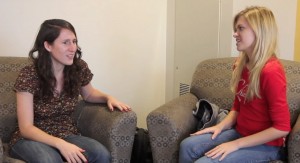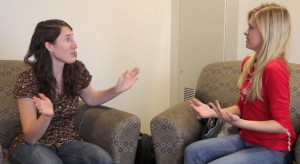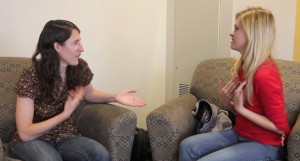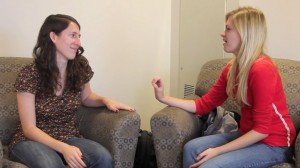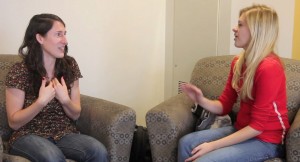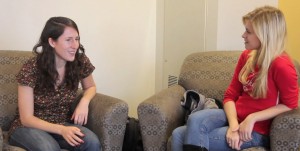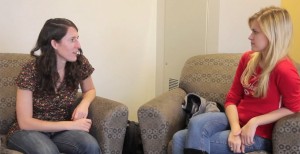In this brief conversation, two friends mirrored each other so consistently, it was uncanny. (They also made almost constant eye contact, which is somewhat unusual, even between close female friends.) Watch as they smile together, frown together, move forward or back together, and gesture together. You don’t need to do nearly this much mirroring to create a sense of connection with the people you talk to.
Both look annoyed (not at each other — they are sharing gripes). Each has one hand reaching out towards the other with similar palms-up gestures, while their other hand rests on their legs. Both are leaning an elbow on the armrest.
Now they both look amused (closed-mouth smiles). Neither is gesturing, both have palms face down (on armrest and/or leg).
Here we do not see much mirroring. (It would be unnatural for them to match all the time!) The woman on the left is gesturing with one arm and has turned her other palm up as she speaks. The woman on the right is laughing in response. She is leaning slightly back (as is common while laughing), while the speaker is leaning forward.
Now their expressions match again (as their faces express disbelief and annoyance — again, not with each other, but appropriate to the messages being uttered), and their palms are again down and at rest. Note that the woman on the right has leaned forward, matching the forward lean of her friend.
SEE WHAT WE MEAN?! Believe it or not, neither woman is consciously matching the other and neither consciously notices that the other is matching her in turn. All they notice is that they’re both enjoying the conversation.
And it continues. The woman on the right gestures towards herself with both hands, and the friend on the right responds with a similar (although one-handed) gesture.
Now it is the turn of the speaker on the right to tell a story, so she has leaned forward even further and is gesturing. The friend on the left is practicing good active listening, keeping her gaze on the speaker and smiling.
The gestures and facial expressions don’t precisely match here, but notice that they have both adjusted their posture, so that neither is leaning as far forward as they were in the photo above.
Now the woman on the left is speaking again. As in the 3rd and 4th photos, she is not making eye contact, signaling that she is taking an extended turn, that she wants to complete her story, while her friend listens attentively.
Although the woman on the right has crossed her legs, their arms and torsos are in almost exactly mirrored positions, and both are smiling.
And, finally, they both stop smiling, showing mutual awareness that the story (and perhaps the conversation) is done.
All this mirroring is in no way staged or premeditated, and the speakers aren’t even aware that they’re doing it. But if one of them failed to do it, the other would unconsciously notice. (She’d get “bad vibes” without knowing why.) She might wonder if there’s something wrong with the conversation (if she has said something to upset her friend, or if her friend is bored with the topic) or if there’s a problem bothering her friend that is distracting her from the conversation. She might even ask, “Is everything okay? You seem kinda distracted.”
